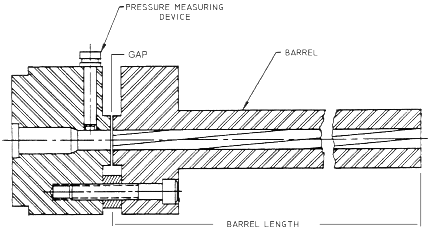 |
|
Vented test barrel |
This section contains brief discussions of various ballistics and shooting related topics as requested by correspondents. If you have a question you have been trying to find an answer to (keep 'em ballistics and shooting related--see your minister for the mysteries of life) email me by clicking here and I'll do my best to find the answer for you and if it is of general interest, publish it here. If you can contribute additional input to one of the answers I'd would appreciate hearing from you too.
Check back frequently as new topics are always being added.
On this page:
How do I duplicate US Military
ammunition when handloading?
What is a vented test barrel?
What does group placement on a target tell the shooter?
Why does the caliber designation of many cartridges
differ from the actual bullet diameter?
Is there issued US military shotgun ammunition?
What is the difference between the
"Picatiny" (M1913) mounting rail and the "Weaver" mounts?
Q. How do I duplicate US Military ammunition when handloading?
A. The following are the specifications for US Small Arms ammunition. If you have a chronograph you simply load the correct weight bullet to the velocity specified. If you don't have a chronograph (shame on you!) some suggested loads using military brass and bullets are listed.
ALL LOADS USE MILITARY BRASS (except the 9 mm),
AND
MILITARY BULLETS (OR
THEIR COMMERCIAL EQUIVALENT).
REDUCE ALL LOADS BY 10% (EXCEPT THE LOAD MARK BY *)
AND WORK UP
|
Military Ammunition Equivalents |
|||
| Cartridge | Bullet Weight (gr) |
Velocity f/s |
Suggested
load(s) |
| M41 .38 | 130 | 950±45 | 6.3 gr PowerPistol, 5.2 gr Unique or Universal |
| M882 9 mm | 124 | 1230±50 | 6.4 gr Accurate #5, 8 gr BlueDot |
| M1911 .45ACP | 230 | 820±25 | 5.2 Bullseye |
| M193 5.56 mm | 55 | 3250±40 | 26 gr. of H335, 26.5 gr TAC |
| M855 5.56 mm [for 5.56 NATO chambers ONLY] | 62 | 3020±40 | 26 gr of TAC |
| MK262 5.56 mm [for 5.56 NATO chambers ONLY] | 77 | 2750±30 | 24.5 gr TAC |
| M80 7.62 mm | 149 | 2750±20 | 42.5 IMR4895, 46 grs. 748 or Ball C2 |
| M118 7.62 mm Special Ball | 173 | 2550±30 | 43 grs. of RL15 or 748 |
| M118 7.62 mm Special Ball LR (Sierra MK bullet) | 175 | 2580±30 | 42.5 grs. of Varget, |
| M852 7.62 mm MATCH (Sierra MK bullet) | 168 | 2550±30 | 41.5 IMR4895 |
| M2 Cal .30** | 150-152 | 2740±30 | 49 grs. IMR4895 49 gr 748 50 gr IMR4064 |
| M72 Cal .30 MATCH** | 173 | 2640±30 | 47 gr IMR 4895 47.5 gr 748 47.5 gr IMR 4064 |
| M1 Cal .30 carbine | 110 | 1900±30 | 14 gr 2400 or 14 gr H-110* |
| * Do
not reduce H110 more than 3% ** Powders list are the best burning rate for use in the M1 Rifle |
|||
One supplier of US surplus components is http://www.gibrass.com
Q. What is a vented test barrel?
A. Originally ammunition for revolvers was pressure and velocity tested in a solid test barrel just like rifle ammunition but using an 8 7/8" (the longest "common" pistol barrel length) barrel. This method of testing led to results that showed abnormally high velocities, quite beyond what was usually achievable in an actual revolver with its typical .006" - .008" cylinder gap. In an attempt to generate more realistic velocity date a vented test barrel is now used for revolver ammunition. The gap is set to .004" and the barrel length is set to a commonly used length for the caliber under test. While the .004" gap is a bit unrealistic the results are closer to the real world than with a solid barrel. Typical differences are shown in the table.
 |
|
Vented test barrel |
|
Test Barrel Differences |
|||
| 4" Revolver | 4" Vented test barrel |
8.875" Solid test barrel |
|
| 158 gr LSWC +P .38Spl | 882 f/s | 919 f/s | 1042 f/s |
| 158 gr JHP .357 | 1191 f/s | 1257 f/s | 1453 f/s |
Q. What does group placement on a target tell the shooter?
A. The charts below explain the meanings of group placement. The descriptions given are for right handed shooters. For left handed shooters flip the drawings left to right.
|
Rifle Target Problems |
||||
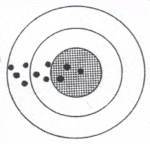 |
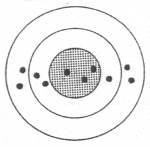 |
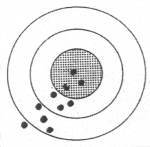 |
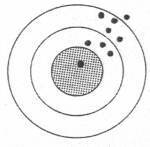 |
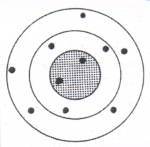 |
|
Finger too deep on trigger. Not pulling the trigger straight back. |
Canting the rifle or not having front sight vertical in the same place shot to shot. | Bucking the rifle. Pushing forward of the shoulder in anticipation of recoil. | Helping or "heeling" the rifle by pushing forward slightly with the heel of the firing hand. | Focusing on the target and not the front sight. |
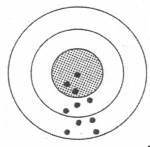 |
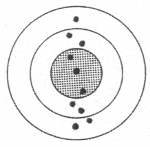 |
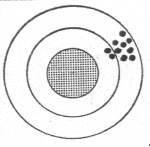 |
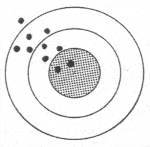 |
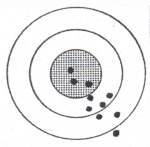 |
| Lose sling or support elbow sliding. | Erratic breathing technique or changing eye relief. | Tight group anywhere off the point of aim mean the shooter is making same error consistently or being out of natural position and muscling the rifle into the bullseye. | Not following through or anticipating the shot and/or recoil. | Jerking the trigger. |
|
Pistol Target Problems |
|||
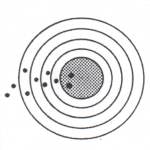 |
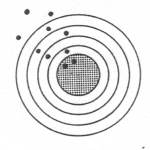 |
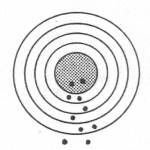 |
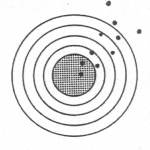 |
| Finger too deep on trigger. | Riding the recoil. (starting the "recoil" before the pistol fires). | Breaking the wrist in anticipation of recoil or relaxing grip at the moment of firing. | Helping or "heeling" the pistol by pushing forward slightly with the heel of the firing hand. |
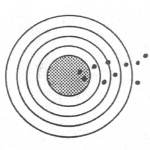 |
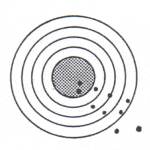 |
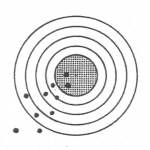 |
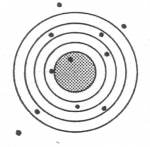 |
| Thumbing. Pressing the side of the pistol with the thumb at the instant of firing. | Tightening grip as the pistol is fired. | Jerking the trigger. | Focusing on target rather than front sight, inconsistent grip. |
Q. Why does the caliber designation of many cartridges differ from the actual bullet diameter?
A. The difference comes from the fact that there are two diameters of interest in a barrel. There is the bore diameter which is measured from the tops of the lands and there is groove diameter which is measures between the deepest part of the grooves. Depending on the manufacturer's preference the cartridge may be named from either of these dimensions. In some cases like the .460 Weatherby, which actually used .458" diameter bullets, the manufacturer my round up the number for advertising purposes. The actual bullet dimension is based upon the groove measurement.
In some cartridges (like the ".38 SPL") the designation may refer to an older design of the cartridge. The common .38 Spl has a bore diameter of .346 and a groove diameter of .357. It's designation is based on the original .38 cartridge, the .38 Long Colt (Navy) which used an oversized outside lubricated bullet of about .378" diameter and a slightly larger bore than current cartridges. And you wonder why the confusion?
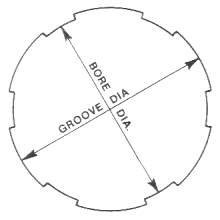 |
The table below gives some common dimensions.
| Cartridge | Bore Diameter (in) |
Bore Diameter (mm) |
Groove (Bullet) Diameter (in) |
Groove (Bullet) Diameter (mm) |
| .22 RF | .217 | 5.51 | .222 | 5.64 |
| .22 Centerfire* | .219 | 5.56 | .224 | 5.68 |
| .243 Win | .237 | 6.01 | .243 | 6.17 |
| .264 / 6.5 mm | .255 | 6.47 | .264 | 6.71 |
| .270 Win/6.8 | .270 | 6.85 | .277 | 7.03 |
| 7 mm | .277 | 7.03 | .284 | 7.21 |
| .30 | .300 | 7.62 | .308 | 7.82 |
| .32 Win | .315 | 8.00 | .320 | 8.12 |
| .338 | .330 | 8.38 | .338 | 8.58 |
| 9 mm | .346 | 8.78 | .355 | 9.01 |
| .38SPL/.357 Mag | .346 | 8.78 | .357 | 9.06 |
| .40 / 10 mm | .390 | 9.90 | .400 | 10.16 |
| .41 Mag | .399 | 10.13 | .409 | 10.38 |
| .44 Magnum | .417 | 10.59 | .429 - .431* | 10.90 - 10.94 |
| .45 Colt | .442 | 11.22 | .450 - .454** | 11.43 - 11.53 |
| .45 ACP | .442 | 11.22 | .450 | 11.43 |
| * Current
SAAMI is .429" ** Current SAAMI is .450" * Includes .22 WMR Rimfire |
||||
Q. Is there issued US military shotgun ammunition?
A. For the most part commercially produced and procured shotgun ammunition is issued. There are, however, some type classified rounds issued. The table below lists the one's I am aware of along with the commercial rounds currently listed in the system.
| Designation |
Identification |
| M19 | All brass case 00 buckshot |
| M162 | Brass and plastic hi-base 00 buckshot |
| M257 | Brass and plastic hi-base #4 buckshot |
| M274 | Brass and plastic hi-base #4 shot |
| M1012(AA31) | Finned "less lethal" rubber slug. Clear plastic case marked "Rubber Fin Stabilized Non Lethal." |
| M1013 | 18 pellets "less lethal" rubber buck shot Clear plastic case |
| AA29 | Beanbag round. Clear plastic case marked "Beanbag-Non Lethal" |
| AA30 | Launcher cartridge. Clear plastic case marked "Launching cartridge." |
| M1030 | Breaching round. 1.4 oz sintered steel projectile. Brass hi-base clear plastic case |
| MK246 Mod 0 (A024) |
Breaching round. Red all plastic cartridge |
| M35 | .410 21/2 inch commercial loading #6 shot |
| A023 | Brass and plastic hi-base commercial 1 oz Slug |
|
AO14 |
Brass and plastic low base commercial 71/2 shot |
| AO17 | Brass and plastic low base commercial 9 shot |
| - | Dummy. Clear plastic case with blackened hi-base metal. Marked "Dummy." |
|
- |
10 gauge commercial blank |
Currently the US military is issuing Remington 870s, Mossberg 500 & 590s, Winchester 1100/1200, and the new M1014 HK/Benelli semi-auto
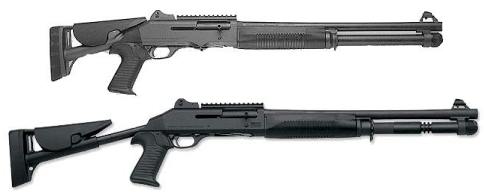 |
|
HK/Benelli M1014
|
Q. What is the difference between the "Picatinny" (M1913) mounting rail and the "Weaver" mounts?
A. The so called “Picatinny Rail” is a standardized mounting system for small arms accessories used by NATO and the US military. The term “Picatinny” comes from the Picatinny Arsenal located in New Jersey, who developed the official specification known as MIL-STD-1913 which specifies the dimensions and tolerances required.
The cross sectional profile of the M1913 and Weaver systems are virtually identical.
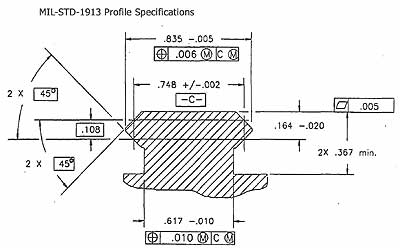
The main difference lies in the placement and the width of the grooves. M1913 grooves are .206” (5.23 mm) wide and have a center-to-center distance of .394” (10 mm). The placement of these grooves has to be consistent in order for it to be a true “Picatinny” M1913 system. Weaver rails have .180” ( 4.57 mm) recoil grooves and are not necessarily consistent in a center-to-center measurement from one groove to the next. Frequently, a Weaver system has a specific application that it is machined for, so interchangeability is not necessarily an issue. A MIL-STD-1913 system must adhere to the specifications listed since the military needs uniformity to allow for different systems to be mounted on the weapon without compatibility concerns.
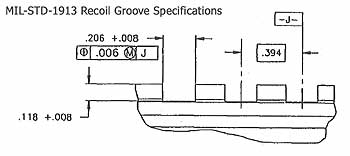
Accessories designed for a Weaver system will, in most cases, fit on M1913 rails, but the recoil lug of Weaver type mounts may not fully engage the shoulder of the M1913 rail. Properly spec'd M1913 accessories probably will not fit most Weaver rails.
Drawings from MIL-STD-1913 (AR) 3 February 1995
Please email comments to Fr. Frog by clicking here.
| Back to Q&A Index | Ballistics Main Page |
| Back to Fr. Frog's Home Page |
Disclaimer
As far as I know all the information presented above is correct and I have attempted to ensure that it is. However, I am not responsible for any errors, omissions, or damages resulting from the use or misuse of this information, nor for you doing something stupid with it. (Don't you hate these disclaimers? So do I, but there are people out there who refuse to be responsible for their own actions and who will sue anybody to make a buck.)
Updated 2020-06-29